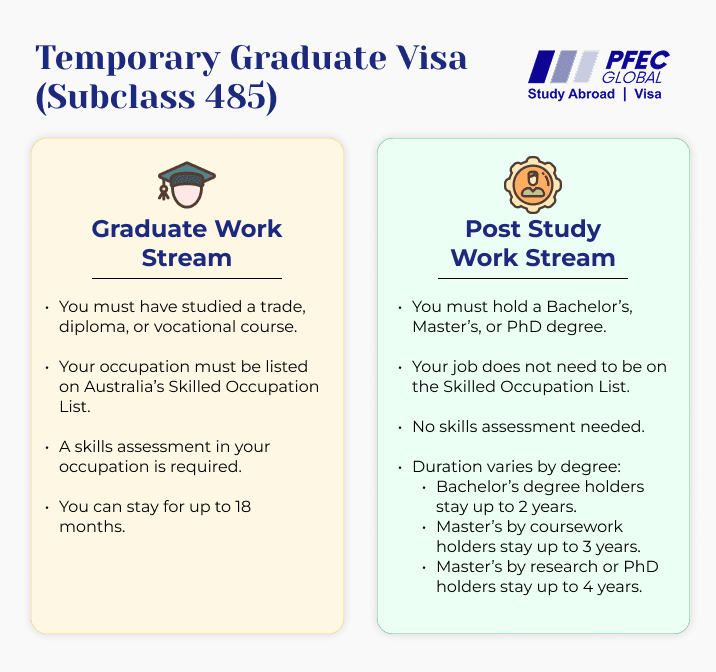General Skilled Migration Visa Australia – Compare Subclass 189, 190, and 491 Visas

Health insurance is an essential requirement for a worry-free experience while studying abroad.
International Medical Coverage: Health insurance provides you with the peace of mind to receive medical care anywhere in the world, ensuring you won't face overwhelming expenses.
Visa and Enrollment Support:Having health insurance can make obtaining a student visa and enrollment easier. This reduces the chances of your applications being delayed or rejected.
Financial Protection: In the event of an unexpected incident, having health insurance ensures that your medical expenses are covered. It safeguards you from potential financial stress.
Legal Compliance: Many countries create specific health insurance for international students. Securing this insurance not only safeguards your well-being but also shields you from potential legal complications and the risk of deportation. Protect yourself and ensure a smooth study experience abroad.
Comprehensive Care: Health insurance covers expenses related to hospital stays, prescription medications, mental health support, and much more.
Register with Us to Take the Next Step
Country-wise rules
The USA has a unique system that students must navigate to meet certain criteria. In contrast, Australia requires international students to have Overseas Student Health Cover (OSHC). Similarly, in the UK, students are obligated to pay an Immigration Health Surcharge (IHS) to gain access to the National Health Service (NHS). Additionally, some universities have their own specific requirements, which often include particular coverage limits in their health insurance schemes.
Selecting a plan
Recognizing the diverse needs of students, universities create customized health insurance policies that provide essential coverage. Students can conveniently enroll in these plans during their registration process, ensuring peace of mind from day one. If a university does not offer its own insurance, students must seek private health insurance, which may not fully meet their specific needs. It's crucial for universities to invest in comprehensive health insurance options that prioritize student well-being and security.
Purchasing Health Insurance
Health insurance is essential for students, and selecting the right plan is vital for their well-being. By carefully considering their unique needs, students can find a plan that offers the best balance of cost and benefits. After choosing a suitable plan and making the necessary payment, students will receive a certificate as proof of their coverage, ensuring assurance during their academic journey.
Country-wise rules
The USA has a unique system that students must navigate to meet certain criteria. In contrast, Australia requires international students to have Overseas Student Health Cover (OSHC). Similarly, in the UK, students are obligated to pay an Immigration Health Surcharge (IHS) to gain access to the National Health Service (NHS). Additionally, some universities have their own specific requirements, which often include particular coverage limits in their health insurance schemes.
Country-wise rules
The USA has a unique system that students must navigate to meet certain criteria. In contrast, Australia requires international students to have Overseas Student Health Cover (OSHC). Similarly, in the UK, students are obligated to pay an Immigration Health Surcharge (IHS) to gain access to the National Health Service (NHS). Additionally, some universities have their own specific requirements, which often include particular coverage limits in their health insurance schemes.
General Skilled Migration Visa Australia – Compare Subclass 189, 190, and 491 Visas
Skilled workers are in high demand across Australia. If you have the right qualifications, Australia offers a structured, points-based pathway to permanent residency through its General Skilled Migration Visa program.
This program includes Subclass 189, Subclass 190, and Subclass 491—each designed for specific applicant profiles. Some offer faster PR, others offer bonus points with state or regional support.
In this guide, we compare all three options side by side. You’ll learn the eligibility, benefits, and commitments of each visa type, so you can choose the best fit based on your score, occupation, and career goals.
What is the General Skilled Migration Program in Australia?

The General Skilled Migration program is Australia’s leading permanent residency pathway for qualified professionals. It aims to bring in skilled workers to address labour shortages in key industries across Australia.
You do not need employer sponsorship for this visa stream. Instead, it is points-tested, which means your application is assessed based on your age, education, English language skills, and work experience.
There are three visa subclasses under the Skilled Migration Program Australia:
- Subclass 189 (Skilled Independent Visa): Offers direct PR with no need for state or employer sponsorship.
- Subclass 190 (Skilled Nominated Visa): Requires a state nomination and gives you 5 extra points.
- Subclass 491 (Skilled Work Regional Visa): Regional visa that grants 15 bonus points and leads to PR after 3 years with evidence of taxable income.
These visas are especially popular among Indian professionals in IT, engineering, accounting, healthcare, and education, where Australia’s demand is consistently high.
Each visa type allows you to live, work, and study in Australia, with varying conditions based on your subclass. Subclass 189 and 190 grant full PR directly. Subclass 491 is temporary but offers a clear PR pathway after meeting regional work and income criteria.
Expert Tip: Subclass 491 is an excellent option if your points are low. It boosts your score by 15 points, which can significantly speed up your invitation, especially if your occupation is only available in regional areas.
Subclass 189, 190, 491 Comparison – Know the Key Differences
Choosing the right visa under the General Skilled Migration Visa Australia program depends on your points score, flexibility, and long-term goals. Here’s a clear comparison to help you decide:
| Criteria | Subclass 189 | Subclass 190 | Subclass 491 |
|---|---|---|---|
| Visa Type | Permanent Residency | Permanent Residency | Temporary (5 years, leads to PR) |
| Sponsorship Needed | No sponsorship | State or Territory Nomination | Regional State or Territory Nomination |
| Points Bonus | None | +5 Points | +15 Points |
| Stay Obligation | No location restriction | Live and work in the nominating state for 2 years | Stay in regional area for 3 years before applying for PR |
| Path to Citizenship | Yes, after 4 years in Australia | Yes, after 4 years in Australia | Yes, after 3 years with taxable income proof |
Expert Tip: If your points are under 70, consider Subclass 491. The extra 15 points from regional nomination can substantially increase your chance of receiving an invitation, especially in competitive occupations like IT and accounting.
PR Visa Through GSM – Which One Should You Choose?
Australia’s Points Test for Skilled Migration determines your eligibility for GSM visas like Subclass 189, 190, and 491. You must score a minimum of 65 points, but invitations typically go to applicants with 70 to 85 points or more.
Points are awarded based on the following:
- Age: Maximum 30 points. Full points if you are aged 25 to 32.
- Education: Up to 20 points. A bachelor’s degree gives 15 points. A master’s or PhD gives 20 points.
- Work Experience: Up to 20 points. You get more for experience in Australia than overseas.
- English Proficiency: IELTS score of 8.0 or PTE score of 79 earns full 20 points.
- Partner Skills: Up to 10 points if your spouse has a skills assessment and competent English.
- Australian Study or Regional Study: Add 5 points each for courses completed in Australia or in regional areas.
Expert Insight: If your score is stuck, improving your English test results is often the fastest way to gain extra points. Target IELTS 8.0 or PTE 79+ for full marks and a stronger position in the SkillSelect pool.
PR Visa Through GSM – Which One Should You Choose?

Choosing the right visa subclass under the General Skilled Migration Visa Australia program depends on your points, flexibility, and occupation. Here’s how to decide between Subclass 189, 190, and 491:
Subclass 189 is ideal for candidates with a points score of 85 or higher and an occupation listed on the Medium and Long-term Strategic Skills List (MLTSSL). This visa does not require any employer or state sponsorship. If granted, you receive permanent residency from day one with no location restrictions.
Subclass 190 is suitable for professionals scoring 70 to 80 points who are willing to live and work in a specific state for at least 2 years. This visa offers 5 bonus points through state nomination and gives you PR status immediately after approval.
Subclass 491 is best for applicants with lower scores (60–65) who are open to moving to regional areas. You gain 15 bonus points through regional nomination. This visa is temporary for 5 years, but you can apply for Subclass 191 PR after 3 years of regional work and meeting income requirements.
Real Examples:
- An IT professional with 75 points and strong English can qualify for Subclass 190 with Victoria or New South Wales.
- A registered nurse with 60 points may receive faster invites through Subclass 491 in states like Tasmania or South Australia.
Expert Tip: Always align your occupation with a state or region that actively invites that role. Review current occupation lists and invitation rounds before deciding your path. This can improve your nomination and shorten wait times.
Eligibility Requirements for GSM Visas (189, 190, 491)
To apply for a PR visa through GSM, you must meet these core requirements. They apply across Subclass 189, 190, and 491, with small differences based on nomination type:
- Age Limit: You must be under 45 years at the time of receiving your invitation.
- Occupation List: Your occupation must be on the relevant Skilled Occupation List. These lists differ between 189 (MLTSSL), 190 (State lists), and 491 (Regional occupation lists).
- Skills Assessment: You need a positive skills assessment from the authorized assessing body for your nominated profession. This is valid for 3 years from the issue date.
- English Language Requirement: A minimum IELTS score of 6.0 overall, or PTE score of 50, is required.
- Health and Character: You must pass a health check and provide police clearance certificates from every country where you’ve stayed for over 12 months in the past 10 years.
- Residency Commitment:
- For Subclass 190, you must live and work in the nominating state for at least 2 years.
- For Subclass 491, you must stay in a designated regional area for 3 years and show taxable income to apply for PR later.
- For Subclass 190, you must live and work in the nominating state for at least 2 years.
Expert Insight: Do not assume your occupation appears on every state’s list. Always download the latest state nomination guides and cross-check your role before submitting your Expression of Interest.
Application Process for General Skilled Migration Visa Australia

The General Skilled Migration Visa Australia application process for Subclass 189, 190, and 491 follows a common structure, with key differences for state or regional nominations.
Step 1: Get a Positive Skills Assessment:
Apply to the relevant assessing authority for your occupation. This confirms that your qualifications and work experience match Australian standards. This is mandatory for all GSM subclasses.
Step 2: Submit Your Expression of Interest (EOI):
Create your EOI profile on SkillSelect. Select the appropriate visa subclass (189, 190, or 491).
If applying for Subclass 190 or 491, choose your preferred state or regional authorities for nomination.
Step 3: Receive an Invitation to Apply (ITA):
If your points meet the current cutoff and your profile matches skill demand, you will get an Invitation to Apply.
For 190 and 491 visas, this happens only after state or regional nomination is approved.
Step 4: Lodge Your Visa Application:
Submit your application via ImmiAccount. Upload all supporting documents and pay the visa fee. Ensure documents are clear, accurate, and officially translated if needed.
Step 5: Complete Health and Character Checks:
Schedule a medical exam with an approved panel physician.
Submit police clearance certificates from every country where you lived for 12 months or more in the past 10 years.
Step 6: Wait for Your Visa Outcome:
Visa processing takes 9 to 15 months, depending on the subclass, document quality, and case complexity.
🔎 Important Note:
Each state or region has different nomination rules, document checklists, and timelines. Always review the latest guidelines on the state migration websites before submitting your EOI.
Expert Tip:
Have all your documents scanned and labeled before submitting your EOI. This reduces delays after receiving an ITA and improves your chances of fast approval.
Costs and Processing Time for Subclass 189, 190, and 491
Understanding the costs and processing time helps you prepare better for your PR visa through GSM.
Visa Application Fee
- AUD 4,640 for the main applicant (approx. ₹2.5 lakh)
- Additional charges apply for spouse and children
Average Processing Time
- Subclass 189 and 190: 9 to 14 months
- Subclass 491: 9 to 15 months (may vary by regional state and nomination conditions)
Additional Costs
- Skills Assessment: AUD 500 to 1,000 (₹27,000 to ₹55,000)
- English Tests (IELTS or PTE): AUD 385 (₹21,000 approx.)
- Medical Exams: AUD 300 to 400 (₹16,000 to ₹22,000 approx.)
- Police Clearance Certificates: ₹500 to ₹1,000 per country
Expert Insight:
Avoid delays by double-checking all document uploads. Ensure file names are clear, scans are high-quality, and translations are certified if your documents are not in English.
Benefits of Applying Through the General Skilled Migration Visa Australia
The General Skilled Migration Visa Australia provides long-term residency, career flexibility, and personal freedom. It remains the most popular PR route for skilled professionals.
Once approved for Subclass 189 or 190, you receive permanent residency from day one. This means you can live, work, or study anywhere in Australia without restrictions.
Subclass 491 offers a clear pathway to PR. You must live and work in a designated regional area for 3 years, with proof of meeting minimum taxable income thresholds to transition to Subclass 191.
All GSM visa holders receive immediate access to Medicare, Australia’s public healthcare system. Your children can attend public schools without paying tuition fees. You can also sponsor eligible family members once you settle in.
After 4 years of residence, including at least 1 year as a permanent resident, you become eligible to apply for Australian citizenship.
Skilled migrants often enjoy strong job prospects and competitive salaries. IT professionals, engineers, and nurses earn an average of AUD 70,000 to 110,000 annually. Regional areas offer additional job demand and settlement incentives.
Expert Insight: GSM visas offer full independence. You choose your job, your location, and your future. No employer lock-ins. No restrictions. Just freedom to grow.
Why Choose PFEC for Your GSM Visa Journey
When applying for a PR visa through GSM, expert guidance can be the difference between quick approval and costly delays.
PFEC Global has helped thousands of professionals secure visas under Subclass 189, 190, and 491. Our team delivers a 98% success rate, backed by deep knowledge of points calculation, occupation lists, and state nomination changes.
We build your case from the ground up. From preparing your skills assessment and selecting the right visa subclass, to structuring your Expression of Interest (EOI) for faster invitations.
You also receive complete document support, ensuring no errors that could delay or cancel your application.
After your visa is granted, we offer post-arrival assistance including:
- Resume and LinkedIn optimization
- Interview preparation for Australian employers
- Job search guidance for both metro and regional locations
- PR conversion strategy if you hold Subclass 491
Expert Tip: Many applicants lose time chasing the wrong state or subclass. We help you align your occupation, points, and goals with the fastest pathway to Australian PR.
Ready to Apply for the General Skilled Migration Visa Australia?
Book your free consultation with a PFEC expert today.
We will assess your profile, verify your points, and recommend the best visa option.
Download the GSM Visa Checklist for a step-by-step breakdown of required documents for Subclass 189, 190, and 491.
Let PFEC guide you from start to PR. Apply with clarity. Move with confidence.



What are my options and possibilities for submitting an Australian PR application?
Depending on your situation, you have many options when applying for an Australian Permanent Residency (PR). The Skilled Work Regional (Provisional) Visa (Subclass 491) is for regional employment; the Skilled Nominated Visa (Subclass 190) is for skilled workers who need state or territory nomination. There are several routes for family sponsorship and employer-sponsored visas, each with particular perks and requirements
If I don't have enough points to submit an application for a PR. What are my options?
If your points total is not enough for a PR application, think about being nominated by a state or territory, which may provide more points. Getting additional job experience, taking language exams like the PTE or IELTS, or going to further school in Australia to improve your credentials are all good ways to improve your English.
Does applying for a new course and student visa when I know my TR (Temporary Resident) is about to expire present any risks?
Applying for a new PR pathway courses in Australia and a student visa while your Temporary Resident visa is about to expire might be dangerous. To prevent possible visa denial, make sure your application is complete and satisfies all Department of Home Affairs standards. Learn the terms of any bridging visa that could be applicable throughout the application process, and if you’re not sure whether your application is complete or if you qualify, get expert help.